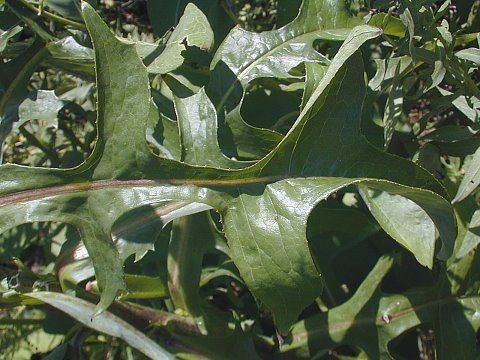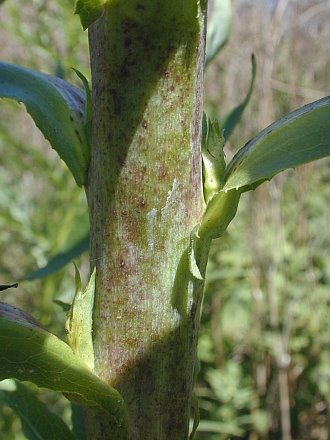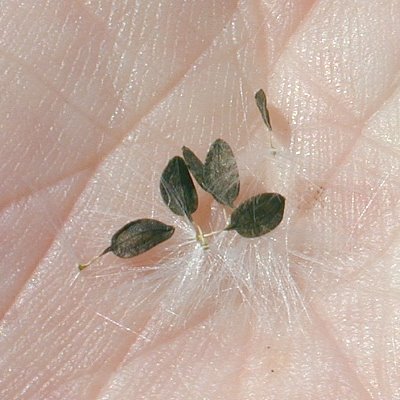Description: This biennial plant is usually unbranched and 3-8' tall. The central stem is terete and glabrous, light green or reddish green (sometimes with purple streaks), and often glaucous. The alternate leaves are light green to dark green, sometimes with purple edges or a yellowish cast. They are up to 10" long, 3" across, and lanceolate-oblong in shape. The largest leaves have deep pinnate lobes, while the smaller leaves have shallow pinnate lobes or none; they are wider at their bases than at their tips, and their bases clasp the stem. Occasionally, the leaves have widely spaced small teeth along their margins and short fine hairs along the underside of their central veins. The leaf surface can be shiny or dull.

The small dandelion-like flowerheads occur in a narrow panicle up to 2' long at the apex of the plant. The petaloid rays of the florets are yellow or slightly reddish orange. Each flowerhead is about 1/3" (8 mm.) across, consisting of 12-25 ray florets. Around the base of each flowerhead, there are several floral bracts (phyllaries) in several series that are appressed together and vary in size. These bracts are light green and glabrous; sometimes they are tinted purple or red. The blooming period occurs during late summer or early fall, lasting about 3-4 weeks. There is no noticeable floral scent. The flowers are replaced by dark brown achenes with tufts of white hair, which are attached together by thread-like beaks. Each achene has a central longitudinal ridge with some black splotches on either side; they are ovoid, flattened in shape, and slightly curved. The length of the achenes is equal to, or greater than, the length of their attached beaks. The inflorescence often has buds, flowers, and achenes existing together in different stages of development. The achenes are distributed by the wind. The root system consists of a thick deep taproot. There is a white latex in the root, leaves, and stems.

Cultivation:
The
preference is full or partial sun, and moist to slightly dry
conditions. Growth is best in fertile loamy soil, although poor
gravelly soil and clay-loam are also tolerated. This plant varies
considerably in size depending on growing conditions. It is somewhat
weedy.
Range & Habitat:
The native Wild Lettuce is a common plant that occurs in almost all
counties of Illinois (see Distribution
Map). Habitats include moist to slightly dry black soil
prairies, clay prairies, gravel prairies, openings in woodlands,
thickets, savannas, lake borders and riverbanks, limestone glades,
fence rows, pastures and abandoned fields, powerline clearances, areas
along railroads and roadsides, vacant lots, and miscellaneous waste
areas. This plant is more common in degraded prairies and disturbed
habitats, although it can also be found in high-quality habitats.

Faunal Associations: The nectar and pollen of the small flowers attract bees primarily, such as the leaf-cutting bee Megachile latimanus and the Halictid bee Lasioglossum lustrans (Robertson, 1929; Estes & Thorp, 1975). The caterpillars of some moths feed on Lactuca spp. These species include Autographa precationis (Common Looper Moth), Grammia virgo (Virgin Tiger Moth), and Cucullia intermedia (Intermediate Cucullia); the caterpillars of the last of these moths feed on the florets. Several aphid species use Lactuca spp. as host plants; they include Hyperomyzus lactucae (Currant-Sowthistle Aphid), Nasonovia ribisnigri (Currant-Lettuce Aphid), Prociphilus erigeronensis (White Aster Root Aphid), Uroleucon ambrosiae (Brown Ambrosia Aphid), Uroleucon gravicorne, Uroleucon pseudambrosiae (False Ambrosia Aphid), Uroleucon sonchella (Sowthistle Aphid), and Pemphigus bursarius (Lettuce Root Aphid). Among vertebrate animals, the Eastern Goldfinch occasionally eats the seeds. Notwithstanding the bitter white latex in the foliage, mammalian herbivores occasionally browse on the foliage of this plant. The Cottontail Rabbit eats the tender leaves of first-year plants, while White-Tailed Deer eats the tops off of more mature plants. Horses, cattle, and sheep also feed on this plant.

Photographic
Location:
The photographs were taken at Meadowbrook Park in Urbana, Illinois.
Comments: This
is a common and weedy plant with a highly variable appearance. It
resembles the non-native Lactuca serriola (Prickly
Lettuce), however the latter has gray achenes that are always shorter
than the thread-like beaks that attach them to tufts of hair. Also, the
leaves of Prickly Lettuce tend to be more blue in appearance, and they
have stout prickly hairs along the central veins on the underside of
their leaves. Wild Lettuce can be distinguished from other native Lactuca
spp. by the color of its flowers, the appearance of its
achenes with attached tufts of hairs, and the absence of hairs on its
stems and leaves (aside from the scattered non-prickly hairs that may
appear along the central veins on the underside of the leaves).